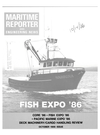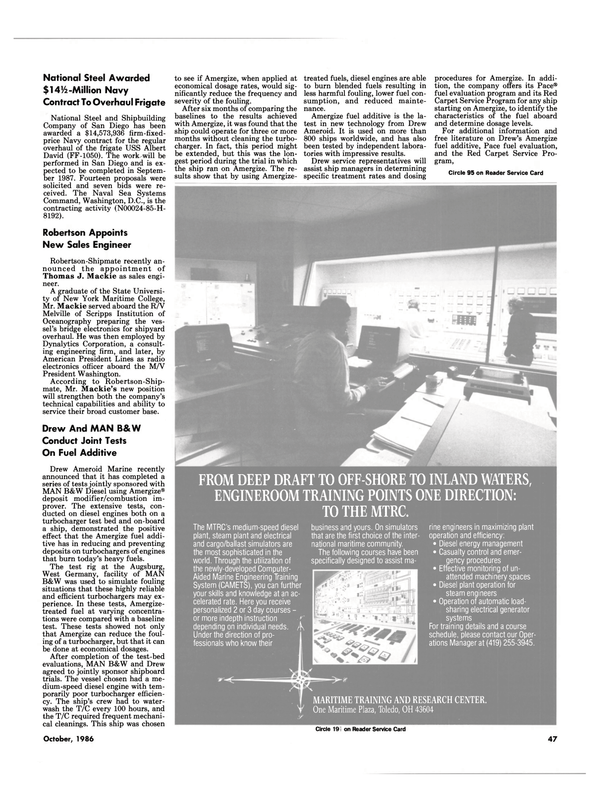
Hyundai Introduces Three Standard Crude Oil Tanker Designs
Recent increases in the oil trade have prompted more tanker owners to bring their laid-up tonnage into service, while studying possibilities of replacing obsolete vessels with competitive new ones. This trend could lead to increased demand for large- and medium-sized tankers, though a more moderate scale than the tanker boom of the early 1970s.
In order to swiftly meet such market conditions, Hyundai Heavy Industries Company, Ltd. (HHI) recently introduced three standard crude oil tanker designs with deadweights of 254,000, 156,000, and 114,000 tons. Their hull form is shaped for minimum resistance and structured for increased speed and greater deadweight capacity with as light a hull weight as possible. They are each equipped with a propulsion plant having a main engine with low fuel rate, and a large-diameter, lowrpm propeller. With the latest navigation equipment, selective cargohandling systems, and economical electrical plants, these prototypes will provide clients with optimum performance and greater economy.
HHI began its shipbuilding operation with the construction of two VLCCs in 1973. Since then the Korean yard has become a leader in the area of crude oil tankers. Its wide experience with this type ship includes delivery of 12 VLCCs, eleven 62,500-dwt crude oil tankers, and four of 80,000 dwt. HHI currently has four tankers on its orderbook, including one 254,000-dwt VLCC.
For further information and free color brochures on HHI's standard tanker designs, Circle 132 on Reader Service Card
Read Hyundai Introduces Three Standard Crude Oil Tanker Designs in Pdf, Flash or Html5 edition of October 1986 Maritime Reporter
Other stories from October 1986 issue
Content
- Wartsila Diesel Acquires Lindholmen Motor page: 5
- Bethlehem Yard Receives $1.9-Million Contract To Repair RRF Reefer page: 5
- 'World Series Contactors And Overload Relays' Brochure Available page: 6
- Bakke New President Of Hempel Coatings (USA) page: 6
- Charles W. Mann Named President, MonArk Boat page: 7
- Bath Iron Works Sold To New York Investor Group page: 8
- SPT Ltd. Offers Free 14-Page Color Brochure On Sound Powered Phones page: 8
- San Diego Shipbuilding Delivers Dinner Cruise Vessel To Bahia Resort page: 8
- Bethlehem-Sparrows Point Receives Navy Contracts Worth $5.1 Million page: 9
- Keel-Laying Ceremony Held At Bethlehem-Sparrows Point Yard For First of Two Navy Survey Vessels page: 9
- Hempel Begins New Campaign page: 9
- Sperry Appoints New Program Manager page: 10
- Volvo Penta's New 61 And 71 Series For Workboats Developed Using Advanced Computer Techniques page: 10
- Falmouth Shiprepair Offers Free Color Brochure On Facilities And Services page: 11
- Master Marine Responds To Change In The Shipbuilding Market With Vessel Conversions page: 11
- Newport News Yard Lays Keel For Carrier 'George Washington' page: 11
- FISH EXPO '86 20th Anniversary Preview page: 12
- New MAN B&W Diesel Engine Extends Two-Stroke Output To Lower Range page: 18
- Avondale To Perform Major Work On The Wisconsin (BB 64) page: 18
- Ulstein Introduces New High-Lift Type Rudder page: 19
- Marinette Marine Awarded $51.8-Million Navy Contract To Build Another MCM page: 20
- Raytheon Signs Sales Agreement With YEW page: 20
- Deck Machinery Ana Cargo-Handling Equipment — A Review— page: 22
- Drewry Predicts Growing Demand For Larger Products Carriers page: 35
- Kamatics Offers New Free 22-Page Catalog On KAron® Bearings page: 35
- Squire-Cogswell To Distribute Robuschi Liquid Ring Vacuum Pumps In U.S. And Canada page: 36
- 12-Page, Full-Color Brochure From Bailey Highlights Marine Control Systems And Services page: 36
- Rolls-Royce Designed Marine Diesels Make U.S. Debut In New Catamaran page: 37
- Innovative Shortsea Vessel Fitted With Unique MacGregor-Navire CAE page: 38
- Cummins-Powered River Queen Delivered By Serodino Shipyard page: 38
- Claremont Offers Free Catalog On Thermal & Acoustical Insulation page: 39
- Quick Delivery Reduces Drydocking Costs For Navy Bearing Replacement page: 40
- $12.2-Million Contract Awarded Swiftships To Build 30 Patrol Boats page: 40
- Peterson Gets $96.6-Million Navy Contract To Build Two Additional MCMs page: 41
- Tideland Introduces New Buoy Design For Deepwater Applications page: 41
- Canadian Offshore Resources Exposition page: 42
- Spinner II Oil Cleaning Centrifuges Reduce Engine Wear Rates page: 44
- Nichols Delivers Another Passenger Catamaran To Red & White Fleet page: 45
- Hyundai Introduces Three Standard Crude Oil Tanker Designs page: 45
- Columbian CF-3 Stainless Propellers Provide High Performance And Long Life page: 46
- Gladding-Hearn Builds Lobster Boat For New Hampshire Firm page: 46
- Drew And MAN B&W Conduct Joint Tests On Fuel Additive page: 47
- PACIFIC MARINE EXPO page: 48
- Fairbanks Morse Supplying Emergency Power For Sohio Drilling Facility In Alaska page: 52
- New GRP Survival Lifeboats From OME Withstand 1,000° C page: 52
- Marathon LeTourneau Awarded Contract To Convert Rig page: 53
- Racal's ISES Improves Ship Operating Efficiency page: 59
- Pittsburgh Brass Offers Free Catalog On Valves And Actuators page: 59
- Free 12-Page Brochure Highlights Avondale's Seven Divisions page: 59
- More Than 500 Vessels Now Coated With Jotun Seaconomy page: 62
- American Ship Awards Contract For Preliminary Passenger Ship Design page: 63
- Free Eight-Page Brochure On Marine Powermeters Offered By Acurex page: 63


